FOR ALL THE LATEST UPDATES, TOURS, WORKSHOPS ETC, PLEASE VISIT MY BIRDING NEWFOUNDLAND WEBSITE.
Kumlien's Gulls of St.John's
I've spent quite a bit of time at our sewer outflow in St.John's this fall/winter, observing the more than 1000 Kumlien's Gulls that can be seen there, at very close range everyday. St.John's is the best location in the world to observe this subspecies of Iceland Gull. I'm particularly interested in studying the variation in Kumliens Gull,which seems endless, at least in regards to their wintip variation, from very black, to almost pure white wing tips.
However,not all characters are this variable. Almost all Kumliens Gull have quite a rounded head and a slight short bill,especially in comparison to Herring Gull,which show a more sloping foredead. The majority of Kumliens are pale eyed,with some as pale as Herring Gull.There are others that have eyes of dark amber, with or without dark spotting.Sometimes the eyes are medium to dark brown. Most have extensive head streaking (often appearing more smudgy in comparison to Herring Gull),while occasionally there are birds that appear quite white headed.However,upon closer inspection, these birds often have a very light brown wash over the head and neck. Invariablym Kumliens have a purple orbital ring,sometimes appearing a light pink/purple.On some birds the orbital ring can very difficult to seem even at very close range. These birds often show only a slight purple pink wash in the orbital ring,just in front of the eye.
Kumliens are very consistent in mantle shade (in my experience) with the overwhelming majority being a shade paler than the average Smithsonianus Herring Gull.On rare occasions, there are birds that appear noticeably darker above than surrounding ICGU's and closely match Herring Gull in mantle color. In my experience these birds often show the most extensive dark in the wing tips as well.
Speaking of wing tips,this is where Kumliens Gulls really get out of whack. The extensiveness of black coloration in the outer primaries is extremely variable. It can range from almost pure white, to being extremely close to Thayer's Gull. These "pseudo Thayers" have medium black coloration on the outer webs of the outer 4 primaries and some even have a small grey mark( always paler than the dark markings in the outer 4 primaries,in my experience) on p5!. With such a high degree of variability it becomes very difficult to conclusively identify a true Thayer's Gull in Newfoundland- the opposite being true in California. We seem to get a few birds each winter that look like good Thayer's Gull 'candidates' in terms of plumage, but these birds are often very slight and look identical to the surrounding Iceland Gulls in structure. As well,particularly in adult birds, there are often other characters that are less then perfect, e.g.eye color,mantle shade,head streaking and most often wingtip pattern.
Essentially, in Newfoundland we are looking for the prototypical Thayer's Gull. For me, this is really the only correct way.Since there seems to be a direct cline from Thayer's to Kumliens,how can one decide where Thayer's ends and Kumliens begins or vice versa? For Thayer's, we need a nice big male with lots of dark brown head streaking,a dark eye,mantle shade at least as dark as Smithsonianus(if not darker) and overall structure tending closer to Herring Gull than an average Iceland Gull. In the wingtips things become a little more complicated. Ideally, p10 would have at least a partial black sub terminal bar, p9 would have a completely black outer web,not interrupted on the outer edge by a white mirror, p8-6 with extensive black outer webs and ideally a black mark if not a broken or full bar on p5. Also, the primaries would be almost jet black with folded wingtip coloration very close to Herring Gull.
Below you will find a series of dark winged presumed Kumliens Gulls all photographed on the same day in St.John's. I will be adding to this collection (especially spread wing shots) in the coming days.
.6.jpg)
A slight bird. Greyish black wingtips.Note the very rounded head,short bill and very pale eye.
.4.jpg)
Wingtips appearing quite black but note how much paler they look below. Slight pale brown wash to head,appearing almost white headed from a distance. Slightly less rounded head than the above bird and bill appering slightly larger- perhaps a male?
.5wingspread.jpg)
Wing tip coloration seems pale for Thayer's and note the white mirror that interrupts the black outer web of p9.Note also black markings on p6-p10.
Typical Kumliens Gull structure. Greyish wingtips,not how the mirror on p9 interrupts the grayish black outer web. THGU can show a wing pattern very similar to this,but the primaries are more extensively black.
Next are two birds that are perhaps more comlicated than those above. Any comments on these two birds are very much welcomed.
%232.1.jpg)
Bird #1. A good THGU candidate.Wing tip,although lacking a black mark on p5, the extreme outer web of p9 is black, with the middle portion of the black outer web interrupted by a 'mimi mirror' that is separated from the main mirror by the dark feather shaft. I've seen photos of THGU from CA. that match this bird almost exactly.
pbase/image/574319
%232.2.jpg)
Bird #2. A somewhat confusing individual.
.jpg)
.jpg)
.jpg)

Surely this is out of range for Kumliens,but what is it??
************************************************************************************************************************************************************************
"Some Thoughts on the Separation of Pale-winged Kumliens and g.glaucoides Iceland Gulls"
This is an article I've been threatening to write for some time. So now finally, at 12:01 tonight I decided to sit down get to work. Before I get into any discussion I should advise that I've never been to Greenland or Iceland and have no real life experience with g.glaucoides in their true range.So, feel free to take what I say with a grain of salt, should you decide to keep reading at all.Having said that I've seen a hell of a lot of Kumlien's Iceland Gulls, and have a good feeling for the limits of variation within that subspecies, if you want to call it that. Over the years, I have looked at every photo of g.glaucoides I could get my hands on, and and photographed a number of individuals in Newfoundland, some of which I will share in this article.
Throughout the course of this article I will discuss the variation in Kumlien's Iceland Gull and compare that to (what I think of) g.Glaucoides. I will discuss criteria for separating these two subspecies (based on a Newfoundland, or perhaps just my, perspective). I will limit my discussion to adult birds only,since I have not seen any reliable way of separating juveniles and fist winter birds. As birds get into their second, and especially third winter, they become easier to separate but as I said, I will concentrate on adult birds. I will give particular attention to those Kumlien's Gulls that could present a possible caveat for those wishing to identify g.glaucoides. Alternately, this may be of use to European birders, who endeavor to identify out of range Kumlien's Gulls.
Newfoundland seems to host the lion share of the winter population of Kumlien's Gulls.While they are very well represented throughout the Canadian Maritimes,with some into the mid west and Great Lakes and down the eastern seaboard into New England, I doubt there is anywhere else on earth one could witness the numbers and diversity of Kumlien's Gulls that we see in St.John's, Newfoundland in winter. This combined with the fact that I just don't have much else to do in winter has afforded me the opportunity to gain an intimate knowledge of Kumlien's Gulls over the last 10-12 years.
Over that time I've witnessed a number of characters that seem to separate Kumlien's from g.glaucoides. Among the more important of these are,
1) mantle shade- Kumliens slightly paler than smithsonianus HERG while g.glaucoides is as pale a Glaucous Gull or paler.
2) eye color- Kumliens can vary from very pale to very dark but ALWAYS has at least some dark peppering in the iris while g.glaucoides ALWAYS has a fully pale eye without dark peppering ranging pale to creamy yellow reminiscent of Glaucous Gull.( I'm open to revising this statement, if someone can provide me with conflicting evidence)
3) Primary coloration- Kumliens varies from having dark marking on as many as 6 outer primaries (though usually 4) to pure white wing tips with dark pigment restricted to the outer web of p10 (sometimes very faint) g.glaucoides never has dark markings or any kind in the wings as adult-- always pure white tips and lacking any dark marbling in the outer web of p 10.
4) structure- On average Kumlien's seem to appear larger billed,with less rounded head. Appear more menacing and bulky overall. The smallest g.glaucoides can appear very dainty with quite small, Dove-like heads.
While there may be other differences,I believe any Iceland combining all of the above characters, one way or the other, can be safely assigned to subspecies. Any Iceland Gull that appears extremely dainty, with a clear yellow eye, pure white wing tips and mantle color matching GLGU is probably, if not certainly a g.glaucoides. At times there are birds that have 3 of 4 of the above characters and are suggestive of g.glaucoides but I choose to leave these birds unidentified.
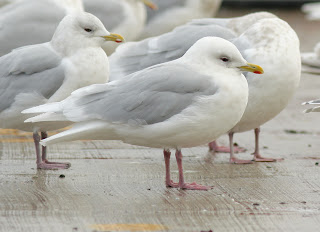
Example of g.glaucoides- like Kumlien's Gull. Structurally very reminiscent of g.glaucoides with smallish bill, rounded head, creating a dainty impression. Wings apparently pure white,lacking any dark markings. However, note mantle coloration same as surrounding Kumliens Gulls and dark eye. What does this mean??
MANTLE SHADE
Kumliens Gulls have a mantle shade just lighter than smithsonianus Herring Gull, but noticeably darker than any Glaucous Gull. In direct comparison with glaucoides Kumlien's appears at least a shade darker. See photos below.

Presumed g.glaucoides,St.John's, Newfoundland,December. Compare to Herring Gull on left and Kumliens Gulls on right and behind. Also note similarity in Kumlien's and Herring Gull mantle shade. Note this individual shows all four key features mentioned above, pale mantle, pure, pale eye,lacking dark peppering, pure white wings. Structurally this bird was a little bulky, so probably a male.

Presumed g.glaucoides, late January, St.John's, Newfoundland. Compare with Kumlieni to the left. There is less contrast between the primaries and mantle in glaucoides then even the whitest winged kumlieni.
EYE COLOR
Eye color is among the most variable of all Kumlien's traits. However, in my experience there are limits. There seem to be a couple of potential rules among the variability.
1) While KUM iris' can appear completely dark to completely pale,there is ALWAYS at least some dark peppering in the iris.
2) In adult g.glaucoides there is NEVER a large amount of dark peppering in the iris. The adult eye color is usually a clear creamy yellow and mostly lacking the more amber and golden tones shown by pale eyed Kumlien's. From what I can see most of the time it lacks any dark spots in the iris whatsoever,but perhaps some can show a few dark specs.
Below are a series of photos displaying the range of eye color possible in Kumlien's Gull with a few g.glaucoides thrown in.


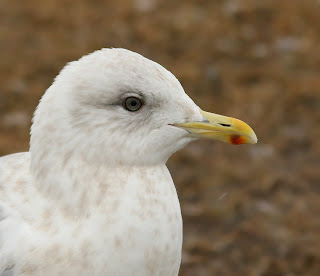


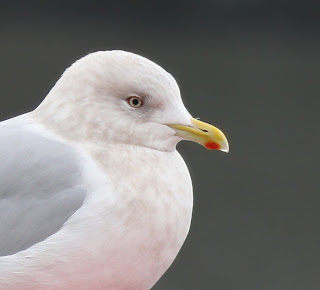

3rd winter g.glaucoides,Newfoundland,January. Note the creamy-yellow color lacking dark peppering.

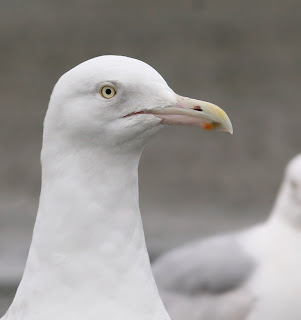
Adult Glaucous Gull, Newfoundland, January. Note similarity to the g.glaucoides above.
PRIMARY COLORATION
This is actually quite straightforward. While Kumlien's Gull can pretty much range from primary patters closely matching those of Thayer's Gull to almost pure white winged as in g.glaucoides. The whitest winged Kumliens have only a very small amount of dark coloration (sometimes limited to light gray marbling) on P10.
In contrast to Kumlien's, adult g.glaucoides NEVER has any dark coloration in the primaries.
Three dark-winged Kumlien's Gull's.



White-winged Kumlien's Gulls
While the above birds would never be mistaken for g.glaucoides there are some more confusing individuals. While some Kum's have dark marking on the outer 5-6 primaries ( usually grayish) there are others that can appear completely pure, white-winged. When you find an Iceland Gull that seems to lack any dark markings in the primaries, its important to remember the other criteria that distinguish Kumlien's and g.glaucoides, such as mantle shade and eye color. Then, if possible scrutinize the wings as closely as possible looking especially for any signs of darker markings on p10,mainly on the lower 2/3rd's of the feather in the outer web. Some examples of pale winged Kumlien's below.





STRUCTURE
Structurally Kumlien's can be quite variable. In general it has a smallish billed and more round headed (less sloping forehead)appearance when compared to Herring Gull. This creates a much more gentle expression and a more overall dainty feel to the bird. Among Iceland Gulls g.glaucoides tend to have an even more dainty appearance than Kumliens, often being shorter bill and having a steeper forehead. I don't have a complete understanding of the structural variability in g.glaucoides, but the individuals I've seen in Newfoundland have all been very short-billed round headed individuals. I'm sure there is much overlap with Kumlien's so this is just an accessory feature to be used along with mantle shade, eye color and primary coloration.

g.glaucoides Iceland Gull February, Newfoundland

g.glaucoides, Iceland Gull, January Newfoundland.
g.glaucoides Iceland Gull, January, Newfoundland. Note the steep forehead and very rounded crown, along with short bill creating gentle expression.
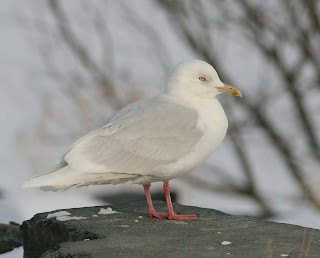
This article is not meant to be a definitive work on the separation of these two subspecies, but rather a discussion of some of my observations here in Newfoundland. As I continue to get a better grasp on the potential variation that exists in g.glaucoides I hope to update this article.We're still learning more about these birds every day!For now I'll leave you with one last photo that serves to accentuate the extreme variation found within this species.

Two Kumlien's Gulls, February, Newfoundland. These two individuals nicely display the extreme variation in primary coloration that
************************************************************************************************************************************************************************
"Yellow-legged Gulls of Newfoundland"
Let me preface this post by saying this is not meant to be a treatise on the identification of Yellow-legged Gulls,there has already been lots written on that topic and better presented than I'm capable of doing here. I'm writing this purely to show what our Yellow-legged Gulls look like in hopes that it might assist other birders in finding Yellow-legged Gulls outside Newfoundland. I'll present evidence to demonstrate that Newfoundland YLGU's are likely of the subspecies atlantis and will also include criteria for separation from possible hybrid look-alikes such as HERG X LBBG. Even though its nice having the monopoly on this species for North America,I suspect a few YLGU's are flying under the radar of east coast birder in other provinces and states.
Most of what we know about Yellow-legged Gull in North America comes from the hard work done by the 'Godfather' of Newfoundland gulling, Bruce Mactavish. Bruce had been finding these mysterious Yellow-legged, dark mantled birds for years before they were ever considered a separate species and long before anyone else cared about them. When I got on the gull watching scene around 2000 a lot of the ground work was already done.
Over the course of the last decade St.John's has seen at least one or two Yellow-legged Gulls every winter. At one point last fall we were able to identify 4 different individuals residing in St.John's in October,which is probably an all time high. Currently there are two individuals in town.
I often get questioned by visiting birders and even locals about what subspecies our YLGU's belong to. Well we kind of assume ours are atlantis(probably from the Azores). I say assume because maybe we can't be 100% certain, but we do have some good supporting evidence to support such a claim. Features of Azorean atlantis( also useful for separation from similar species) displayed by typical Newfoundland YLGU's include the following:
1) mantle color (The rare shade of gray)between Herring Gull and graellsi Lesser Black-backed Gull, but tending closer to LBBG. However, this can change dramatically depending on light conditions and the background substrate, i.e. grass,water, snow.

YLGU in back. Compare mantle color intermediate between HERG in front and LBBG in middle. Also note the head shapes of the three birds- photographed St.John's Oct 14,2010.

Looking quite dark mantled in late day sun. Notice pure white headed from a distance and typical blunt ended "butter knife" shaped bill, created by a steeply curved upper mandible. Photographed St.John's Dec 2/2009.

Here with Herring Gull.Compare difference in mantle shade. Also, note pure white head,deep red orbital ring and gape and thick yellow legs. Photographed St.John's Feb 01,2010.
2) extensive head streaking(late summer-late fall)- over the last few years we have been finding YLGU's in late summer (August). This has allowed us to see the dense head streaking characteristic of atlantis and Azorean birds in particular. The streaking is most dense around the eye as in LBBG and is mainly restricted to the head, rarely a few spots reaching the nape or throat- NEVER the breast as in some LBBG, HERG and LBBG X HERG hybrids.

Head fully streaked appearing more dense around eye (streaking appeared darker in life). Also note active moult state with all primaries either growing or replaced, with only p10 retained. LBBG's seen on the same day still had a number of unmoulted primaries. Photographed Aug 30/2010 at St.John's.

Almost appearing hooded from a distance is characteristic of Azorean YLGU's.Dark marking son bill are probably acquired as a result of basic plumage since there are no other apparent signs of lingering immaturity. dark markings in the bill seem rare in our brand of YLGU. Also notice active moult state with p9 and p10 still growing. Photographed St.John's Oct 08,2006, by Bruce Mactavish

Another photo displaying extensive winter head streaking. Photographed St.John's Oct 11/2010

Photo displaying remnants of winter head streaking. When YLGU's lose head streaking they tend to retain it in the lores and forehead the longest. Seen here on Dec 28/2010. Most Newfoundland YLGU's are white headed by early January or late December. Birds such as this can appear to be pure white headed from a distance.
3) primary pattern- extensive black on outer 4 primaries, p6-p10. Always a black band of varying width(often thinish) on p5 and occasionally a black mark on p4 on the inner web only. This is purely a guess but I'd say that <20 a="" adult="" all="" almost="" also="" and="" another.="" anything="" apical="" based="" be="" being="" black="" but="" closed="" closer="" display="" evenly="" fact="" for="" fully="" get="" grown="" have="" href="https://blogger.googleusercontent.com/img/b/R29vZ2xl/AVvXsEialOT9-I2Pluso6sJN6kel-Hr7a5HfoBeh-O9SYmJeqJUOyUX6QvHUhvFc0qvduSzHJuDfQmwSg8SKlWWbWtSH6sn5KojX1bEJmwe2NQ0n5N0Ko0fbjzS9FvsKYhwBtWTbeZSIRmn-u63T/s1600/YLGU%2528primary+patterm%2529.jpg" in="" is="" larssen="" little="" lying="" mark="" may="" michahellis="" moderately="" most="" narrowly="" not="" note="" observation="" of="" olsen="" on="" over="" p4.="" p5-p6="" p6-p7="" p7-p8="" p8-p9="" p9-p10="" pattern="" personal="" potentially="" primaries="" primary="" reliable="" s="" separated="" separating="" show="" spaced="" spaces="" spacing="" spots.="" spots="" states="" subspecies.="" that="" the="" they="" typical="" very="" we="" widely="" will="" wing.="" ylgu="">

Note extensive black in wing tips and sharp demarcation of black primaries against grey portions of the flight feathers. Mirror on p10 only,black in p9 and p10 reaching primary coverts and full band on p10 typical of atlantis YLGU's. Also a mark on p4 restricted to just outer web.Based on my research this seems more typical of Azorean YLGU's, but many Azores birds do not not have it. When it is there it seems to be restricted to the inner web. Photographed at St.John's Nov 11,2010.
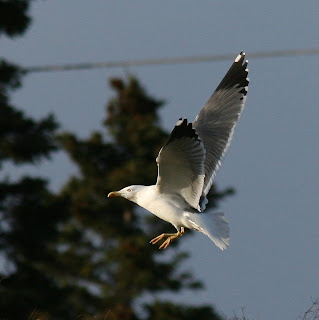
Similar wingtip as above. Photographed at St.John's Dec 02.2009

This is the more common primary pattern for Newfoundland YLGU's,with black in outer six primaries ,mirror on p10 only, with a thinnish band on p5. To my knowledge we have never had a YLGU with a mirror on p9. This would seem to be supporting evidence of the Azores being the point of origin for out YLGU's since according to Olsen and Larssen <2 17="" a="" azorean="" have="" href="https://blogger.googleusercontent.com/img/b/R29vZ2xl/AVvXsEgUWSF04o4TYOvL3FmDJ7GMr_opvUJxpaAtmMNJBPaFUYOBW6KRPLLiL-GUSPs-Pq5BlOB7kE5e578sjKMGp-AX_MZ4FyLCWCixcxoWsZBBzg2khoxgvUxEgymhPvV6wvQ2mTR27EXh8-mo/s1600/YLGU-wings-out-13-Jan-2008-+BM.jpg" mirror="" oct="" of="" on="" p9.="" photographed="" s="" st.john="" ykgu="">
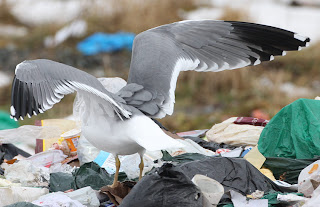
Another typical primary pattern for Newfoundland YLGU's. The thickness of the band on p5 can vary,but its always there and when thin is always thicker on the outer web. Photographed Jan 14/2008 Bruce Mactavish
4) structure- Newfoundland YLGU's tend to present as a fairly compact bird, relatively short and seeming powerful, thick legs, with a full breast and wide shoulders. The head tends to show a sloping forehead with a flat crown and angular nape. In certain postures YLGU's can show a somewhat unique flat topped head with a sharply squared crown. Our YLGU's often look slightly smaller that Smithsonianus Herring Gull. They are equally chesty, but their seemingly shorter legs may create this impression.
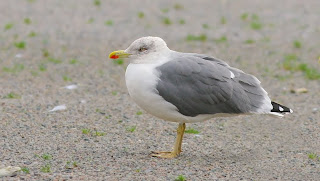
Showing typical head shape with sloped foreheard,flat toped head and angular crown. Note also the hunched appearance of this individual, this might be a subtle jizz feature for our YLGU's. Photographed at St.John's,Oct 11/2009.

Here showing the extreme flat head and angular crown that which is is typical of the species, but especially atlantis. Note this bird apepared a little darker in life, but in certain lighting YLGU's mantle shade can be close only a couple shades darker than Smithsonianus Herring Gull. Note also the intensity of the deep red orbital ring. Photographed Feb1é2010,St,John`s.

Some atlantic YLGU's can appear more round headed especially when alert. This bird is quite white headsed for the date. Photographed Oct 11/2009 St.John`s.

Another typical fall YLGU,with extensive hood of streaking restricted to the head,showing characteristic head shape, deep red orbital ring and blunt tipped bill all characteristic. Photographed Oct 08/2006 Bruce Mactavish.
Bart Parts- As it`s name suggest YLGU`s have yellow legs as adults. Apparrently a small minority can have flesh colored legs, but all of the YLGU`s we`ve identified in Newfoundland have had dull to bright yellow legs. Along with leg color orbital ring color is another importan tfeature in YLGU. In alternate plumage all YLGU have brightédeep red orbital rings. IN basic plumage the orbital ring tends to take on varying amounts of orange coloration. Bill color and shape are also good markers in YLGU. The species is known for having a thick bill with a sharpely curved culmen,creating a blunt tipped bill. There is repots in the literature of YLGU`s gony spot bleeding into teh upper mandible. While I`ve seen this feature in some of our YLGU`s, this is not the case for all of them. Below are a few head shots featuring orbital ring and bill coloration and shape. Leg color acan be seen well in the previous images.

Photographed Oct 14/2009 at St.John's

Photographed September 2006 at St.John's, Bruce Mactavish
Two individuals showing characteristic basic plumage bare parts coloration. Note orbital ring and gony orange/red- red. By late December into January both the orbital ring, gony spot and gape of these birds starts to turn a much deeper red. See the next photo for an example.

Note the much deeper red orbital ring and gony spot of this alternate plumaged YLGU. Photographed Feb 01/2010 at St.John's.
Essentialy nominate Michahellis should be a little larger, slightly paler mantled,have less head streaking in late summer/fall (not appearing hooded), appearing longer legged and stand a greater chance of having a mirror on p9, with almost 50% of nominate Michahellis showing this feature. I can't recall a single Newfoundland YLGU ever showing a mirror on p9. If around 30-50% of Michahellis have a mirror on p9 (according to Olsen and larrsen) one would think we would have seen one that displayed that feature by now.
Circumstantial evidence that supports my claim that Newfoundland Yellow-legged Gulls originate in the Azores is provided by a couple of immature birds that have been identififed as being of Azorean stock. These include a 3rd winter bird from 2008 that seems ot have been widely accepted as an Azorean atlantis. As well, there is a 2nd winter bird from 2007 that seems (to me at least)a shoe in for an Azorean atlantis.
So, for the gull watching trying to find a YLGU, look for a Herring Sized gull with a mantle color between Herring Gull and graellsi LBBG,with a white or mostly white head (after mid December). It must have bright yellow legs, red orbital ring and gony spot (noticeable at some distance). The wings have a great deal of black on the primaries which is sharply demarcated from teh grey portions of the wing. It will most likley have a single mirror on p10 only and must have a complete black band on
p5. after you see al this, take as many photos as you can, call you friends then go home and celebrate a terrific bird!
NOTE: The hybrid discussion and photos are yet to come.
************************************************************************************************************************************************************************
"Separation of YLGU and LBBG X HERG Hybrids"
Since the last post was quite long I thought it better to devote a separate post for this topic. In this post I will cover the separation of Yellow-legged Gull from the very similar Herring X Lesser-Black-backed Gull hybrids. For the purposes of this discussion I will be focusing only on adult birds and the comparison will be made between atlantis subspecies Yellow-legged Gulls and Herring (unknown ssp) X Lesser-Black-backed Gull (presumed Graellsi)hybrids.
This problem of HERG X LBBG hybrids is becoming increasingly relevant as the numbers of LBBG's in North America continue to increase. We have already had several instances of hybridization between graellsi LBBG's and Smithsonianus HERG's. A very well documented example and some nice discussion by Kirk Zufelt can be found here The Expansion of LBBG Some discussion about the discovery of a LBBG paired with a HERG on Appledore Island NH an be found here Appledore Gull As well,there have been several documented insyances of suspect LBBG X HERG hybrids getting friendly with Herring Gulls in Labrador,but no evidence of mating. The issue of HERG X LBBG hybrids is problematic enough, when you consider what a LBBG X HERG paired with a HERG would produce....well I don't even want to think about it!
Anyway, I'm getting off track , the purpose of this article is to discuss the separation of atlantis YLGU's from HERG X LBBG hybrids, so lets get started on that. I'm going to compare Yellow-legged Gull and HERG X LBBG hybrids based on their main points of separation, namely, mantle color, winter head streaking, bare parts coloration and wing tip pattern. I will not make any inferences about moult timing, since for hybrids,this is at best poorly understood,but from my experience most HERG X LBBG hybrids seem to follow a predominantly LBBG type moult schedule.
Mantle Color
This is often the first thing I look for when searching for YLGU's among mixed gull flocks in St.John's. When I'm guiding and I can't find a YLGU for my client I will sometimes seek out a LBBGXHERG hybrid to show them the mantle color we are looking for. This works great because atlantis YLGU's and HERGXLBBG hybrids seem to have identical mantle shades.

Not surpriseingly hybrid HERG XLBBG's have a mantle shade that is pretty much perfectly intermediate between those two species. Incidentally, atlantis YLGU's happen to shade that very same shade of gray. One small difference may be that the hybrids can look a little bluer. That could just be the way I see them.
Winter head Streaking
One of the most well known feature of YLGU's are their tendency to be purely white headed in winter. They are usually not free of the last remnants of winter head streaking until early January, although it's probably possible in December. This is when separating YLGU's from potential hybrids is much easier because the potential pitfall hybrid combos will have head streaking lae into winter and some even early spring. I saw two hybrid LBBG's yesterday and both still had extensive head streaking while the YLGU near by was completely and beautifully white headed and has been that way for almost two months.

HERG X LBBG hybrid- Photographed St.John's Jan 28th
Note the extensive head streaking, even extending down onto the breast. This manner of head streaking would never be possible in YLGU,especially so late into winter.

YLGU- Photographd St.John's Jan 30th
This is what every YLGU should look like by the second or even the first week of Jauary. If there are any remnants of winter head streaking it will be restricted to the lores and forehead. After the first week of jan any YLGU with extensive Head streaking, isn't a YLGU!
Bare Parts
In winter separating YLGU from LBBG hybrids is relatively straightforward. I have never seen a LBBG hybrid show bright yellow legs in winter. In summer all bets are off, the legs get scary bright on these things, but in winter they tend to show at best yellowish or maybe straw colored legs. Often times the legs appear flesh colored with yellowish spots, mainly around the knee joints. By contrast YLGU's ALWAYS have yellow legs. That is except for a very small percentage of apparently fleshy colored individuals. All the YLGU's we've identified in NL, have had nice yellow legs in all seasons, getting brighter as winter progresses. In my experience they are NEVER yellowish, pale yellow, greenish or any other permutation of yellow. If you see a YLGU that doesn't have pure yellow legs, it probably isn't a YLGU!

Note leg color and mantle color compared to immature LBBG to the right. Photographed at St.John's Feb,2009.

In my experience this is about as yellow as LBBG hybrid legs get in winter. These will probably be bright yellow in late spring.early summer. Photographed in St.John's Jan 2009.

Another example of standard leg color for HERG X LBBG hybrid.

Here is YLGU showing probably as dull yellow legs as you will see. Note while they are a dullish yellow, they are still a pure yellow without any greyish, greenish or flesh tones. These become bright yellow by mid December. Photographed in St.John's mid October 2010.
Aside from leg color, there are also differences in orbital ring color and to a lesser extent bill coloration. LBBG hybrids commonly show an orangy yellow or orange orbital ring, while YLGU orbitaj rings are usually deep red. As stated in the previous article, in early fall when at the height of basic plumage some YLGU's can show an orangy red orbital ring. Therefore its important to consider the date of obsevation when separating YLGU's from potential hybrids.

Note: Standard lookng head of HERG X LBBG hybrid in mid winter. Lots of head streaking, extra concentrated around the eye. Orange orbital ring,pale, clear eye and bill with decent sized gony spot with some subterminal black markings in the bill. In my expereince most LBBG hybrids show these black markings in the bill in winter, while only a minority of YLGU's will.

Typical YLGU from late December onwards.Pure white head, deep crimson orbital ring,large red gonys (does not need to bleed into upper mandible), clear, ple eye and clean bill, lacking black markings.Many will also show an extensively red gape line.

Even when streaking headed in latesummer and early fall YLGU's will never show streaking onto the breast and lower nape lik most HERG X LBBG hybrids do.
Primary Pattern.
Separating YLGU's from possible hybrids based on primary pattern is not exactly strightforward, especially since they can show the same general pattern of black on the outer 6 primaries, p5-p10, with a single mirror on p10 only and a black band on p5. Upon closer inspection though there are some differences to be noticed.
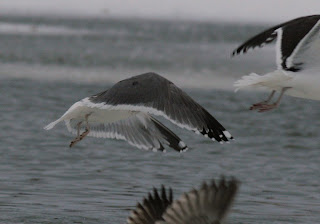

While generally quite close to YLGU, ths wing tip shows several differences. Notes especially the reduced black on p8 and the grey tongues eating into the blakc on p6 and p7. As well,there is extremely minimal black on p5, barely forming a thin broken band on only one wing. That smal mirror on p9 on the right wing also is a strike against YLGU.

This wing tip is closer to YLGU than the one above but notes especially the reduced black on the inner webs particularly on p6 and p7. Even more important are the pale moons lie between the blak and gry on p5-p7. These are not seen on YLGU. This is pretty sibtle though and you'd probably want a photo to show them.

Pehaps the most YLGU type wing possible in a HERGXLBBG hybrid. In fact this primary pattern is probably inseparable from msot atlantis YLGU's in the field. There are a couple of differences to note- based on my experience. The pale moons on p5-p7 are still there, much rduced, but still visible. As well,the black sub terminal band on p1 is considerable. In my experience out YKGU's generally show a thinner subterminal band on p10. Ofte when our YKGU's show a subterminal band this thick on p10,they will also have a black mark on p4. Compare teh above wing tips with the YLGU wings below.

Note the thin subterminal band on p10 (no black on p4. Compare p5-p7 with the above birds, notice the lack of pale white moons where the black meets the grey areas on the primaries.

Note the thicke subterminal band paired with black mark on p4. Also lacking pale moons p5-p7. The blakc on mark on p4 is critcal here. According to Olsen and Larssen only %25 of atlantis have a mark on p4. I have never seen a HERGX LBBG hybrid with a mark on p4. Doesn't mean it can't happen, but it's probably pretty unusual.
When identifying YLGU out fo range and especially when ruling out hybrid combinations it's critically important to consider multiple characters and avoid jumping to conclusions based ona singe trait such as leg or mantle color. As you cna see above there is some overlap between YLGU and HERG X LBBG hybrids in many traits and one should be very careful to first rule out this hybrid combination before claiming any YKGU out of range.
************************************************************************************************************************************************************************
.2.jpg)
.1.jpg)




